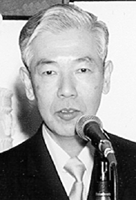Obituaries: Jin-Ichi Nagumo
June 17, 2000

Jin-Ichi Nagumo, 1926-1999
Born in Tokyo in 1926, Nagumo obtained a PhD in applied physics from the University of Tokyo in 1954. From 1953 to 1959, he was an associate professor in the Department of Applied Mathematics at Keio University in Tokyo. He then moved to the University of Tokyo, first as an associate professor in the Department of Applied Physics (1959-1963) and then, from 1964 until his retirement (in 1987), as a professor in the Department of Mathematical Engineering and Information Physics. From 1982 to 1984, he also served as dean of engineering.
Nagumo made fundamental contributions in the fields of nonlinear circuit theory, bioengineering, and mathematical biology. In 1962, he, Suguru Arimoto, and Shuji Yoshizawa proposed a simplified version of the celebrated Hodgkin-Huxley equation describing the behavior of action potential along nerve axons. This equation, often called the FitzHugh-Nagumo equation, generated considerable interest among mathematicians and biologists; it played a fundamental role in efforts to understand the behavior of the propagation of the action potential in nerve membranes and made detailed mathematical analysis tractable. The ongoing influence of this work is measured by the recent appearance of related papers in SIAM Journal on Applied Mathematics and SIAM Journal on Mathematical Analysis.
In 1967, Nagumo and Haruhiko Noda proposed a method for system identification based on learning algorithms. Their work is considered one of the earliest such attempts. Throughout his career, Nagumo was interested in nonlinear phenomena. It was this aspect of biological phenomena that triggered his interest in bioengineering and pattern recognition. His aim was to apply the understanding of biological mechanisms to practical engineering applications.
He was the leader of a large national project on pattern information processing, which was funded by MITI in Japan from 1973 to 1984. One result of the project was a significant increase in interactions between academia and industry in Japan.
Nagumo received numerous honors in the course of his career, including the Purple Ribbon Medal (1987) and The Second Order of the Sacred Treasure (1997), both from the Japanese government. Elected an IEEE Fellow in 1981, he was cited "for contributions to researches on bioengineering including neuron modeling, medical electronics, human engineering, and on systems analyses especially of nonlinear distributed systems."
He is survived by his wife, Urara, his son, Natsuhiko, and his daughter, Haruna.
---Naoki Saito, Department of Mathematics, University of California, Davis (with the assistance of Shuji Yoshizawa, Saitama University, Japan).

